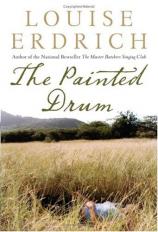The Painted Drum
Review
The Painted Drum
The tale of the Ojibwe painted drum is told in three parts that
twine and weave together through the past and the present. In the
first, Faye Travers, an estate appraiser who is part-Ojibwe, is
called to the home of a recently deceased neighbor where she
discovers an incredible collection of American Indian artifacts.
The neighbor was a descendant of an Indian agent on the Ojibwe
reservation where Faye's grandmother lived as a child.
A drum in the collection calls to Faye --- literally. She alone
hears a low note from it as she steps close. The drum is enormous
and exquisitely decorated with beads, tassels, small tin cones, and
a painted yellow line. Faye is strangely moved by the drum. As a
result, she does something unthinkable: she steals it.
Faye's lover, artist Kurt Krahe, is lost in sorrow. His daughter
died recently. Previously aloof, he has become determined to grow
close to Faye; Faye feels that he wants to somehow own her. As he
reveals more to her of himself, she discovers he has been lying to
her. While previously she longed for a better connection with
Krahe, Faye now pulls away --- even more so when Krahe suggests
reviving the apple orchard, the scene of a tragedy that has shaped
Faye's life since childhood.
In the second part of the tale, the story's viewpoint shifts to
Bernard Shaawano, who lives on the reservation. Faye and her mother
bring the drum "home." The drum is pivotal to Bernard's family
history, which he tells. His story is filled with passion,
betrayal, unthinkable sacrifices, and survival. Shaawano explains
how the painted drum came to be made by his own grandfather who was
prompted to build it by the ghost of his lost daughter. The making
of the drum resurrected Bernard's grandfather's wrecked life,
giving him purpose and inspiring him to quit drinking. Previously
friendless, he found himself with "more help than he could manage,
and more advice than he could trust" as he prepared to fashion the
drum. Yet he is also guided by dreams, spirits and visions as he
begins his quest.
The third story opens with nine-year-old Shawnee desperately trying
to feed her small brother and sister. They've eaten the family's
toothpaste, and now drink diluted cough syrup and eat the crumbs
found below cupboard liners. Shawnee's mother, Ira, has gone to
town desperately trying to find help for her children, landing
finally in a bar where she hopes to barter sex for money in order
to buy food. Meanwhile, her children are freezing and starving at
home. Shawnee's efforts to keep her siblings warm end disastrously.
As the little girl hauls her brother and sister through an icy
night, she hears something no one else can.
The intertwined tales, which celebrate the courage of girls both
alive and ghostly, are beautifully told. The stories reaching far
into the past seem more vibrant, while Faye's contemporary tale,
though enjoyable, fades a bit in contrast, functioning more as a
backdrop. This is a difficult book to read at times, yet is so
compelling that it's impossible to put down. Although the tales can
be harrowing, they feel authentic and leave the reader with a fine
upturn of hopefulness.
Louise Erdrich is always a joy to read, with her gorgeous prose,
haunting tales and fascinating characters. Very highly
recommended.
Reviewed by Terry Miller Shannon (terryms2001@yahoo.com) on January 14, 2011
The Painted Drum
- Publication Date: September 1, 2005
- Genres: Fiction
- Hardcover: 288 pages
- Publisher: HarperCollins
- ISBN-10: 0060515104
- ISBN-13: 9780060515102





